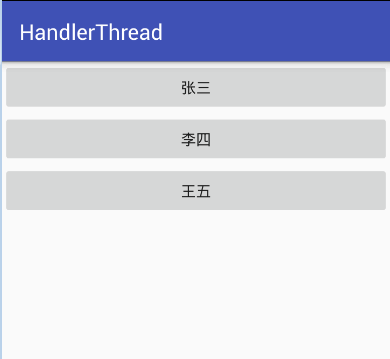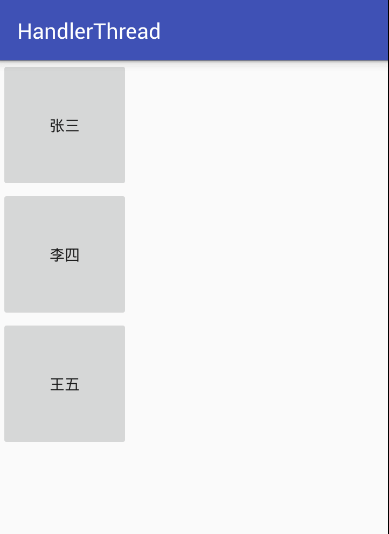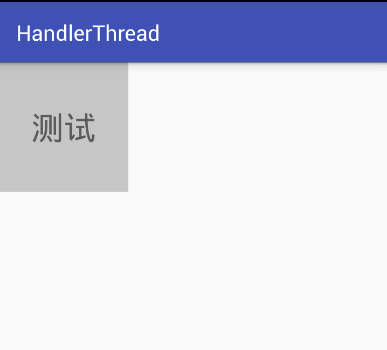LayoutInflater深度解析
1.概述
对于Inflate的三个参数(int resource, ViewGroup root, boolean attachToRoot),很多人可能有这样的误解:
- 如果inflate(layoutId, null )则layoutId的最外层的控件的宽高是没有效果的
- 如果inflate(layoutId, root, false ) 则认为和上面效果是一样的
- 如果inflate(layoutId, root, true ) 则认为这样的话layoutId的最外层控件的宽高才能正常显示
是否是真的像这样呢?今天我们就从源码的角度去探究:
2.案例
我们就采用一个ListView,item为一个按钮
Activity的布局文件:
<?xml version="1.0" encoding="utf-8"?>
<ListView xmlns:android="http://schemas.android.com/apk/res/android"
xmlns:tools="http://schemas.android.com/tools"
android:id="@+id/mListView"
android:layout_width="match_parent"
android:layout_height="wrap_content" >
</ListView>
item的布局文件:
<?xml version="1.0" encoding="utf-8"?>
<Button xmlns:android="http://schemas.android.com/apk/res/android"
xmlns:tools="http://schemas.android.com/tools"
android:id="@+id/btn_test"
android:layout_width="120dp"
android:layout_height="120dp" >
</Button> ListView的适配器:
/**
* Created by quguangel on 2016/12/1.
*/
public class MyAdapter extends BaseAdapter {
private String[] listData;
private LayoutInflater mInflater;
public MyAdapter(String[] listData,Context mContext){
this.listData = listData;
this.mInflater = LayoutInflater.from(mContext);
}
@Override
public int getCount() {
return listData.length;
}
@Override
public Object getItem(int i) {
return listData[i];
}
@Override
public long getItemId(int i) {
return i;
}
@Override
public View getView(int i, View view, ViewGroup viewGroup) {
if(view == null){
view = mInflater.inflate(R.layout.listview_item_layout,null);
holder = new ViewHolder();
holder.button = (Button) view.findViewById(R.id.btn_test);
view.setTag(holder);
}else{
holder = (ViewHolder) view.getTag();
}
holder.button.setText(listData[i]);
return view;
}
ViewHolder holder;
static class ViewHolder{
public Button button;
}
}
主Activity:
package qu.com.handlerthread;
import android.os.Bundle;
import android.support.v7.app.AppCompatActivity;
import android.widget.ListView;
public class ListViewActivity extends AppCompatActivity {
private static final String[] datas = {"张三","李四","王五"};
private ListView mListView;
@Override
protected void onCreate(Bundle savedInstanceState) {
super.onCreate(savedInstanceState);
setContentView(R.layout.activity_list_view);
mListView = (ListView) findViewById(R.id.mListView);
mListView.setAdapter(new MyAdapter(datas,this));
}
}我们主要关注getView里面的inflate那行代码:下面我依次把getView里的写成:
1、convertView = mInflater.inflate(R.layout.item, null);
2、convertView = mInflater.inflate(R.layout.item, parent ,false);
3、convertView = mInflater.inflate(R.layout.item, parent ,true);
分别看效果图:
效果图1:convertView = mInflater.inflate(R.layout.listview_item_layout, null);

效果图2:convertView = mInflater.inflate(R.layout.listview_item_layout, parent ,false);

我们现在只通过运行1,2效果图就可以看出,这两种方式加载的布局明显不同,这与我们上面的所说的不一样。真的是这样吗?等下揭晓。
效果图3:convertView = mInflater.inflate(R.layout.listview_item_layout, parent ,true);

看到第三种情况,你是不是感到特别的惊讶,没错,就是报错了。
从这三幅效果图可以看出,这三种方式加载的布局现实后效果完全不一样。
inflate(R.layout.listview_item_layout, null)的确不能正确处理宽高,但是并非和
inflate(R.layout.listview_item_layout, parent ,false)显示的效果相同,而它可以完美的显示正确的宽高,
对于inflate(R.layout.listview_item_layout, parent ,true)却报错了,等下我们源码来分析为啥会报错。
由此可知:我们前面所说的3个结论明显有错误。
3.源码解析
下面我们通过源码来解释这三种加载方式的差异
这三个方法,最终都会执行下面的代码:
public View inflate(XmlPullParser parser, ViewGroup root, boolean attachToRoot) {
synchronized (mConstructorArgs) {
final AttributeSet attrs = Xml.asAttributeSet(parser);
Context lastContext = (Context)mConstructorArgs[0];
mConstructorArgs[0] = mContext;
View result = root;
try {
// Look for the root node.
int type;
while ((type = parser.next()) != XmlPullParser.START_TAG &&
type != XmlPullParser.END_DOCUMENT) {
// Empty
}
if (type != XmlPullParser.START_TAG) {
throw new InflateException(parser.getPositionDescription()
+ ": No start tag found!");
}
final String name = parser.getName();
if (DEBUG) {
System.out.println("**************************");
System.out.println("Creating root view: "
+ name);
System.out.println("**************************");
}
if (TAG_MERGE.equals(name)) {
if (root == null || !attachToRoot) {
throw new InflateException("<merge /> can be used only with a valid "
+ "ViewGroup root and attachToRoot=true");
}
rInflate(parser, root, attrs, false);
} else {
// Temp is the root view that was found in the xml
View temp;
if (TAG_1995.equals(name)) {
temp = new BlinkLayout(mContext, attrs);
} else {
temp = createViewFromTag(root, name, attrs);
}
ViewGroup.LayoutParams params = null;
if (root != null) {
if (DEBUG) {
System.out.println("Creating params from root: " +
root);
}
// Create layout params that match root, if supplied
params = root.generateLayoutParams(attrs);
if (!attachToRoot) {
// Set the layout params for temp if we are not
// attaching. (If we are, we use addView, below)
temp.setLayoutParams(params);
}
}
if (DEBUG) {
System.out.println("-----> start inflating children");
}
// Inflate all children under temp
rInflate(parser, temp, attrs, true);
if (DEBUG) {
System.out.println("-----> done inflating children");
}
// We are supposed to attach all the views we found (int temp)
// to root. Do that now.
if (root != null && attachToRoot) {
root.addView(temp, params);
}
// Decide whether to return the root that was passed in or the
// top view found in xml.
if (root == null || !attachToRoot) {
result = temp;
}
}
} catch (XmlPullParserException e) {
InflateException ex = new InflateException(e.getMessage());
ex.initCause(e);
throw ex;
} catch (IOException e) {
InflateException ex = new InflateException(
parser.getPositionDescription()
+ ": " + e.getMessage());
ex.initCause(e);
throw ex;
} finally {
// Don't retain static reference on context.
mConstructorArgs[0] = lastContext;
mConstructorArgs[1] = null;
}
return result;
}
} 1.首先拿到我们加载XML文件的属性值
2.声明View result = root; 最终值返回result。
View temp;
if (TAG_1995.equals(name)) {
temp = new BlinkLayout(mContext, attrs);
} else {
temp = createViewFromTag(root, name, attrs);
}
在这里我们创建了View;
if(root!=null)
{
params = root.generateLayoutParams(attrs);
if (!attachToRoot)
{
temp.setLayoutParams(params);
}
} 可以看到,当root不为null,attachToRoot为false时,为temp设置了LayoutParams.
继续往下看:
if (root != null && attachToRoot)
{
root.addView(temp, params);
} 可以看到,当root不为null,attachToRoot为true时,将temp按照params添加到root中
if (root == null || !attachToRoot) {
result = temp;
} 可以看到,当root为null,直接将temp赋值给result;最后返回result。
从上面的分析已经可以看出:
Inflate(resId , null ) 只创建temp ,返回temp
Inflate(resId , parent, false )创建temp,然后执行temp.setLayoutParams(params);返回temp
Inflate(resId , parent, true ) 创建temp,然后执行root.addView(temp, params);最后返回root
由上面已经能够解释:
Inflate(resId , null )不能正确处理宽和高是因为:layout_width,layout_height是相对了父级设置的,必须与父级的LayoutParams一致。而此temp的getLayoutParams为null
Inflate(resId , parent,false ) 可以正确处理,因为temp.setLayoutParams(params);这个params正是root.generateLayoutParams(attrs);得到的。
Inflate(resId , parent,true )不仅能够正确的处理,而且已经把resId这个view加入到了parent,并且返回的是parent,和以上两者返回值有绝对的区别,还记得文章前面的例子上,MyAdapter里面的getView报的错误:

这是因为源码中调用了root.addView(temp, params);而此时的root是我们的ListView,ListView为AdapterView的子类:
直接看AdapterView的源码:
@Override
public void addView(View child) {
throw new UnsupportedOperationException("addView(View) is not supported in AdapterView");
} 看到这里就能解决我之前出现的异常呢。
4.进一步探究
主Activity的布局文件:
<?xml version="1.0" encoding="utf-8"?>
<TextView xmlns:android="http://schemas.android.com/apk/res/android"
xmlns:tools="http://schemas.android.com/tools"
android:id="@+id/mTextView"
android:layout_width="120dp"
android:layout_height="120dp"
android:text="测试"
android:textSize="30sp"
android:gravity="center"
>
</TextView>主Activity:
public class ListViewActivity extends AppCompatActivity {
private LayoutInflater mInflater;
@Override
protected void onCreate(Bundle savedInstanceState) {
super.onCreate(savedInstanceState);
setContentView(R.layout.activity_list_view);
mInflater = LayoutInflater.from(this);
View testView1 = mInflater.inflate(R.layout.activity_list_view,null);
View testView2 = mInflater.inflate(R.layout.activity_list_view,
(ViewGroup)findViewById(android.R.id.content),false);
View testView3 = mInflater.inflate(R.layout.activity_list_view,
(ViewGroup)findViewById(android.R.id.content),true);
Log.e("le","testView1="+testView1 +"testView1.layoutParams="+testView1.getLayoutParams());
Log.e("le","testView2="+testView1 +"testView2.layoutParams="+testView2.getLayoutParams());
Log.e("le","testView3="+testView1 +"testView3.layoutParams="+testView3.getLayoutParams());
}
}
可以看到我们的主Activity并没有执行setContentView,仅仅执行了LayoutInflater的3个方法。
注:parent我们用的是Activity的内容区域:即android.R.id.content,是一个FrameLayout,我们在setContentView(resId)时,其实系统会自动为了包上一层FrameLayout(id=content)。
按照我们上面的说法:
view1的layoutParams 应该为null
view2的layoutParams 应该不为null,且为FrameLayout.LayoutParams
view3为FrameLayout,且将这个button添加到Activity的内容区域了(因为R.id.content代表Actvity内容区域)
下面看一下输出结果,和Activity的展示:


可见,虽然我们没有执行setContentView,但是依然可以看到绘制的控件,是因为
View testView3 = mInflater.inflate(R.layout.activity_list_view,
(ViewGroup)findViewById(android.R.id.content),true)
这个方法内部已经执行了root.addView(temp , params); 上面已经解析过了。
也可以看出:和我们的推测完全一致,到此已经完全说明了inflate3个重载的方法的区别。相信大家以后在使用时也能选择出最好的方式。不过下面准备从ViewGroup和View的角度来说一下,为啥layoutParams为null,就不能这确的处理。
5.从ViewGroup和View的角度来解析
如果大家对自定义ViewGroup和自定义View有一定的掌握,肯定不会对onMeasure方法陌生:
ViewGroup的onMeasure方法所做的是:
为childView设置测量模式和测量出来的值。
如何设置呢?就是根据LayoutParams。
如果childView的宽为:LayoutParams. MATCH_PARENT,则设置模式为MeasureSpec.EXACTLY,且为childView计算宽度。
如果childView的宽为:固定值(即大于0),则设置模式为MeasureSpec.EXACTLY,且将lp.width直接作为childView的宽度。
如果childView的宽为:LayoutParams. WRAP_CONTENT,则设置模式为:MeasureSpec.AT_MOST
高度与宽度类似。
View的onMeasure方法:
主要做的就是根据ViewGroup传入的测量模式和测量值,计算自己应该的宽和高:
一般是这样的流程:
如果宽的模式是AT_MOST:则自己计算宽的值。
如果宽的模式是EXACTLY:则直接使用MeasureSpec.getSize(widthMeasureSpec);
对于最后一块,如果不清楚,不要紧,以后我会在自定义ViewGroup和自定义View时详细讲解的。
大概就是这样的流程,真正的绘制过程肯定比这个要复杂,就是为了说明如果View的宽和高如果设置为准确值,则一定依赖于LayoutParams,所以我们的inflate(resId,null)才没能正确处理宽和高。






















 484
484

 被折叠的 条评论
为什么被折叠?
被折叠的 条评论
为什么被折叠?








